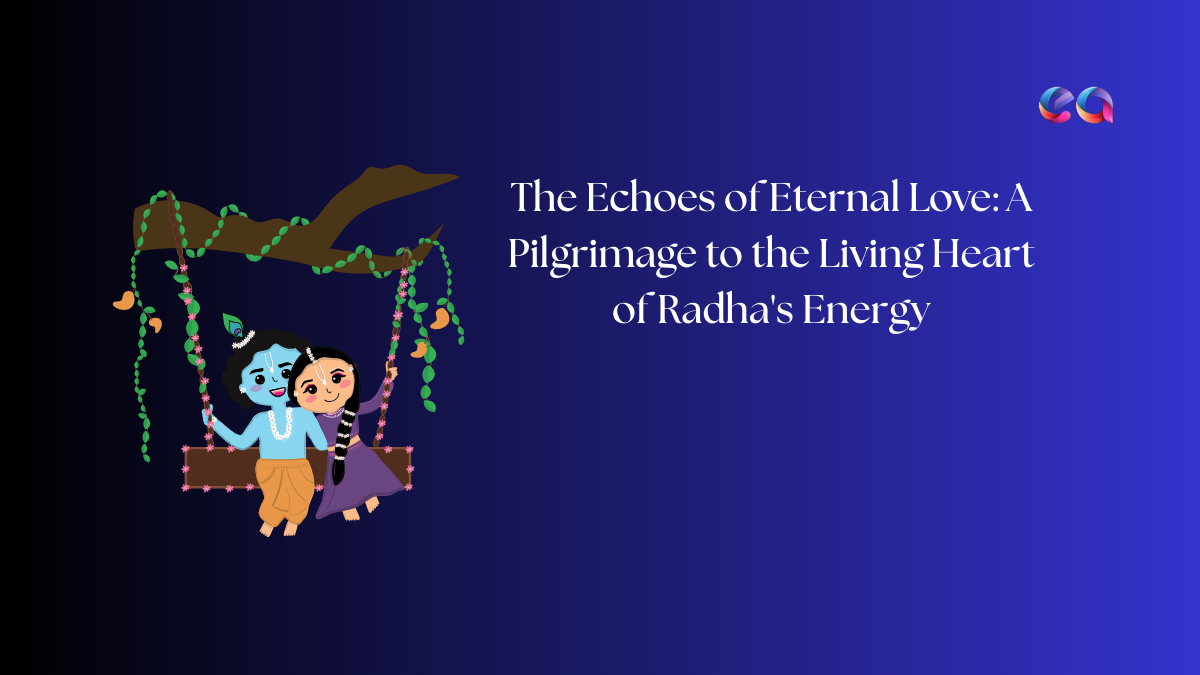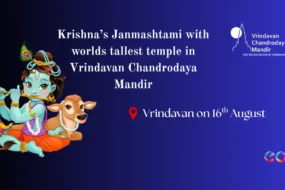
What if a love story was so powerful, so pure, that its energy transcended time and space, leaving an indelible mark on the very earth itself? This is the profound belief that guides millions to a sacred land in India, a place where the divine feminine is not a distant deity but a living, breathing presence. This journey is a pilgrimage to the heart of Radha’s energy, a quest not for tourist landmarks, but for a deeper understanding of a spiritual bond that defines the essence of devotional Hinduism.
In the mystical tapestry of Hindu spirituality, Radha is far more than a figure from ancient lore. She is the divine feminine counterpart to Lord Krishna, the embodiment of prema-bhakti, the highest form of divine love. In Vaishnavism, the tradition that worships Vishnu as the supreme lord, Radha serves as an archetype of the human soul (Atman) in its profound and longing pursuit of the supreme consciousness, Krishna (Brahman). The love between Radha and Krishna is not a simple romance; it is a celestial bond that represents the merging of the individual with the divine, a spiritual union that transcends all worldly duality.
This article is an invitation to embark on a spiritual journey, a narrative pilgrimage to five key locations in India where Radha’s presence is felt most strongly. These places are not just geographical coordinates; they are sacred landscapes where the very air is believed to resonate with the whispers of their eternal love. By exploring the myths, symbols, and spiritual significance of these sites, one can begin to understand the enduring power of Radha’s energy and its timeless message of love and devotion.
Table of Contents
The Soul of Devotion: Understanding Radha’s Enduring Significance
To truly appreciate the living energy of these sacred sites, it is first necessary to understand Radha’s central role in the devotional tradition. She is revered as the eternal consort of Lord Krishna and his most beloved gopi (milkmaid) during his enchanting leelas (divine plays) in Vrindavan. Her character is a profound representation of unconditional love and selflessness. She is so deeply intertwined with Krishna that they are considered inseparable, a unity that texts describe with beautiful analogies, such as being as united as “milk and its whiteness” or “heat cannot be separated from fire”. This relationship is the core of their spiritual union, symbolizing the eternal interplay of divine feminine and masculine energies.
A deeply philosophical dimension of their relationship is found in its portrayal as a Parakiya love, a love that exists without social foundation or marriage. In Hindu mythology, Radha was married to another
gopa, making her bond with Krishna one that existed outside of conventional societal norms. This aspect of their story is not a flaw or a transgression, but a deliberate spiritual metaphor. By depicting a love that defies worldly rules and expectations, the mythology makes a powerful statement about the nature of the soul’s relationship with the divine. It teaches that the bond between the individual soul and God is a pure, personal, and unconditional connection that transcends all human-made institutions, attachments, and societal obligations. This spiritual truth—that the most sacred love is one of unadulterated devotion—is what makes Radha the ultimate example of a devotee.
This divine love story has been the source of immense inspiration for centuries. Its influence is not confined to the pages of scripture but is woven into the living culture of India. It has inspired a vast body of lyrical poetry in various Indian languages, most notably the 12th-century Sanskrit epic, the Gita Govinda by Jayadeva, which beautifully details the love between Krishna and Radha. The bhakti movement, a path of devotion that emphasizes personal worship, was profoundly shaped by this narrative, elevating Radha to a principal deity who is worshipped alongside Krishna in temples across northern and eastern India. This enduring legacy demonstrates that the love of Radha and Krishna is not a relic of the past; it is a living tradition that continues to inspire spiritual seekers to cultivate a similar spirit of devotion.
Barsana: The Genesis of Prema
The pilgrimage to the heart of Radha’s energy begins in Barsana, her revered birthplace and eternal residence, located approximately 52 kilometers from Mathura. The very name of the village holds a spiritual significance that sets the tone for the entire journey. As explained by local saints, “Barsana” means the “falling, scattering, or spreading” of Srimat Radharani’s boundless mercy and compassion onto all who visit this sacred land.
The landscape of Barsana itself is a testament to its cosmic importance. The village is nestled amidst four hills, each said to be one of the four heads of Lord Brahma, the creator god, who took this form to witness Radha’s divine childhood pastimes. These hills—Vrishbhanu Garh, Dan Garh, Vilas Garh, and Man Garh—imbue the environment with a profound spiritual energy. It is believed that Radha’s parents, Vrishabhanu and Kirtida, were blessed with a child who did not open her eyes until the moment she was touched by the infant Krishna, revealing her eternal connection to him.
The most powerful expression of the divine relationship is found at Maan Mandir. Situated atop Mangarh Hill, this is the very place where Radha would retreat when she was upset with Krishna for not coming to meet her. There is a small cave below the temple where she is said to have hidden and wept. The narrative of Radha’s maan, or divine sulking, might seem contradictory to the idea of a perfect divine love. However, within the spiritual tradition, this emotional expression is revered. It demonstrates that the relationship between the soul and God is not static or devoid of feeling. It includes the entire spectrum of human experience—longing, playful jealousy, and the profound pain of separation. The stories of Maan Mandir and the nearby Prem Sarovar, a lake formed from the teardrops of Radha and Krishna, reveal that the path of bhakti is a dynamic and deeply emotional investment. The sorrow of separation (viraha) becomes a catalyst that intensifies the longing for reunion, making the final union all the more sweet and ecstatic. Radha’s willingness to express this full range of emotion makes her the ultimate guide to devotion, showing that the spiritual journey is one of heartfelt surrender.
Vrindavan: The Stage of Eternal Leela
If Barsana is the birthplace of prema, then Vrindavan, located on the banks of the Yamuna River, is the sacred stage for its eternal performance. It is described as a land resonating with Krishna’s flute melodies and Radha’s devotion, a place where “every pebble seems to whisper tales of their love”. This town is the epicenter of the divine leelas (divine plays) of the divine couple and the gopis, a place where devotion and spiritual ecstasy are palpable in the very air.
Among Vrindavan’s many sacred sites, Nidhivan stands out for its aura of mystery and deep spiritual significance. This tranquil grove is steeped in folklore, with devotees believing that Radha and Krishna engage in their eternal Rasa Lila (dance of divine love) here every night. The site is famously protected by a belief that no one is permitted to stay after sunset. The lack of specific ancient scriptural references and the pervasive atmosphere of mystery are not seen as a deficit, but as a core component of the site’s spiritual power. This suggests that the most profound and intimate divine pastimes are not meant for human observation. The sacredness of Nidhivan lies not in what can be physically seen, but in the spiritual energy that is believed to permeate the space, reinforcing the deeply personal and private nature of the soul’s relationship with the divine. The collective faith of generations breathes life into this mystical place, inviting a personal, heartfelt connection that transcends rational proof.
Another powerful testament to the enduring nature of Radha’s energy is Prem Mandir, the “Love Temple”. This magnificent temple, inaugurated in 2012, stands as a grand architectural marvel of white Italian marble, a modern tribute to the ancient love story of Radha and Krishna. The temple’s intricate carvings and exquisite sculptures depict the divine leelas of Radha and Krishna, bringing their ancient tales to life for a new generation. The temple’s very existence, built on such a grand scale in the modern era, is a profound statement. It demonstrates that devotion is not a relic of the past but a living, breathing tradition that continues to inspire new expressions of faith. The temple’s grandeur and the use of pristine white marble symbolize the purity and enduring power of prema-bhakti. Its open doors to visitors of all faiths further reinforce the universal, transcendent message of love and unity that Radha and Krishna embody.
Also Read: Why Krishna’s Janmashtami Is No Ordinary Birthday
Radha Kund: The Water of Unconditional Devotion
The climax of this spiritual journey is a visit to Radha Kund and Shyam Kund, twin ponds located near Govardhan Hill, which are considered the supreme holy places of love and bliss. The legend of their creation is a powerful and dramatic narrative that serves as the ultimate testament to Radha’s pure devotion. According to the Bhagavata Purana, the story begins when Krishna slays a demon named Aristasura, who had taken the form of a bull. In a playful act, Radha and her friends, the gopis, accuse Krishna of being impure for killing a creature from the cow family and refuse to associate with him until he purifies himself by bathing in all the holy rivers.
In response, Krishna playfully strikes the ground with his heel, creating a large hole into which he summons all the holy rivers of the world. He fills this pond, names it Shyam Kund, and declares it to be holier than all other sacred places. Unimpressed, Radha and the gopis accept his challenge to prove her love by creating an even holier pond. They dig their own hole next to Shyam Kund, using their bangles. Though Krishna offers to fill her pond with water from his, Radha and the gopis refuse, vowing they would rather die than accept his help. In an act of ultimate purity and devotion, they decide to fill the pond with their own tears of love. As they cry, the pond miraculously fills, becoming more beautiful and fragrant than Shyam Kund. Amazed by the power of her love, Krishna names the pond Radha Kund, and declares that it is as dear to him as Radha herself.
It is worth noting that while the core narrative remains consistent across sources, some details may vary slightly. In a living, devotional tradition, such variations are not seen as factual inconsistencies but as a natural part of an evolving, organic mythology. The spiritual truth conveyed by the story—the unparalleled purity and power of Radha’s love—is what matters most, transcending any minor differences in the telling. The twin ponds are revered as the “liquid forms of Radha and Krishna,” and bathing in them on the auspicious day of Bahulastami is believed to purify the soul and bless one with the ultimate prema-bhakti, the selfless and unconditional love that Radha embodies.
The Living Legacy: Finding Radha’s Energy Within
The pilgrimage to Barsana, Vrindavan, and Radha Kund reveals that Radha’s energy is not a relic of the past but a living force that continues to shape the spiritual landscape of India. The sacred hills of Barsana tell tales of divine emotion, the mystical groves of Vrindavan whisper of eternal love, and the sacred waters of Radha Kund stand as a testament to the supreme power of devotion. The journey to these places is an external reflection of an internal process, a quest to connect with the divine in its most loving and intimate form.
The universal message of Radha’s energy is a timeless invitation for all. Her story encourages the cultivation of unconditional love, surrender, and selfless service as a means to attain union with the divine. Her unwavering devotion to Krishna serves as a powerful example, demonstrating that a full-hearted emotional investment is the key to spiritual liberation. The pain of separation, the depth of emotion at Maan Mandir, and the tears that formed Radha Kund all show that the spiritual journey is not about avoiding emotion but about feeling it fully, allowing it to become a bridge to the divine.
This spiritual connection is not limited to a physical pilgrimage. It is a journey of the heart, a personal quest that anyone can undertake. By reflecting on the divine essence of these sacred sites, a seeker can begin to find that same energy—the living heart of Radha’s energy—within their own soul, bringing them closer to the transcendental bliss that defines the love of Radha and Krishna.
A Journey Through Radha’s Leela: Sacred Sites and Their Significance
| Location | Primary Significance | Key Legend/Story | Deeper Meaning |
| Barsana | The Birthplace of Devotion | The eternal residence and birthplace of Radha, whose name signifies the “spreading of mercy.” The village is said to be formed by four hills, representing the four heads of Lord Brahma. | The physical manifestation of divine mercy and compassion, where the very earth holds sacred meaning. |
| Maan Mandir | The Expression of Divine Emotion | Located on Mangarh Hill, this is where Radha would retreat and express her feelings of longing and playful anger when Krishna did not come to meet her. | A testament to the full-hearted emotional nature of bhakti, showing that divine love includes the entire spectrum of human feeling, from joy to separation. |
| Nidhivan | The Stage of Eternal Dance | A mystical grove where it is believed that Radha and Krishna perform their intimate Rasa Lila every night. Devotees believe that a spiritual energy permeates the grove, and no one is allowed to stay after dusk. | The most profound spiritual experiences are intimate and personal, transcending human observation and reinforcing the sacred, private nature of the soul’s divine connection. |
| Prem Mandir | A Modern Testament | A magnificent, modern temple built of white Italian marble and inaugurated in 2012, dedicated to the divine love of Radha and Krishna. It stands as a contemporary tribute to their ancient lore. | Devotion is a living tradition that continues to inspire new generations and serves as a bridge between ancient mythology and modern spiritual practice. |
| Radha Kund | The Power of Pure Love | A sacred pond created by Radha’s tears of love after she refused to accept water from Krishna’s pond. She filled her own pond with the purity of her devotion, a testament to its supreme power. | The story of Radha Kund shows that pure, selfless love, transcending all worldly conditions, is the most powerful force for spiritual purification and connection. |













